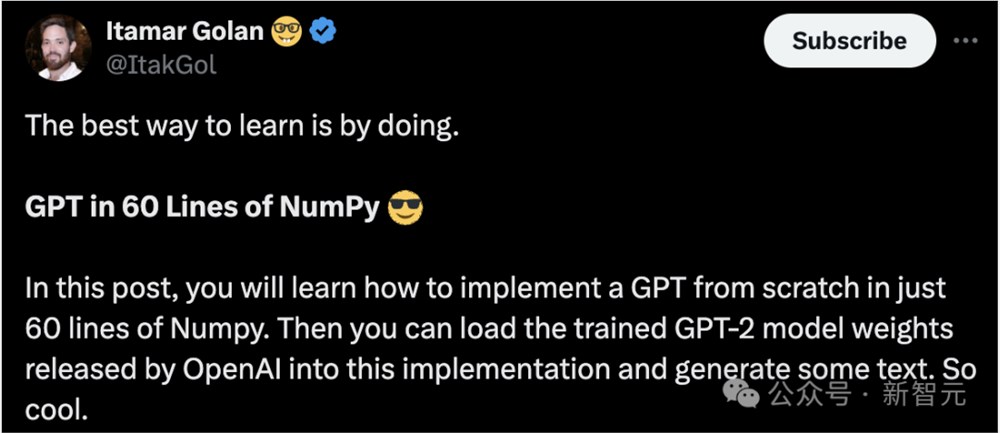60行代码,从头开始构建GPT!最全实践指南来了
声明:本文来自于微信公众号 新智元(ID:AI_era),作者:桃子,授权站长之家转载发布。
【新智元导读】GPT早已成为大模型时代的基础。国外一位开发者发布了一篇实践指南,仅用60行代码构建GPT。
60行代码,从头开始构建GPT?
最近,一位开发者做了一个实践指南,用Numpy代码从头开始实现GPT。
你还可以将 OpenAI发布的GPT-2模型权重加载到构建的GPT中,并生成一些文本。

话不多说,直接开始构建GPT。

什么是GPT?
GPT代表生成式预训练Transformer,是一种基于Transformer的神经网络结构。
- 生成式(Generative):GPT生成文本。
- 预训练(Pre-trained):GPT是根据书本、互联网等中的大量文本进行训练的。
- Transformer:GPT是一种仅用于解码器的Transformer神经网络。
大模型,如OpenAI的GPT-3、谷歌的LaMDA,以及Cohere的Command XLarge,背后都是GPT。它们的特别之处在于,1) 非常大(拥有数十亿个参数),2) 受过大量数据(数百GB的文本)的训练。
直白讲,GPT会在提示符下生成文本。
即便使用非常简单的API(输入=文本,输出=文本),一个训练有素的GPT也可以做一些非常棒的事情,比如写邮件,总结一本书,为Instagram发帖提供想法,给5岁的孩子解释黑洞,用SQL编写代码,甚至写遗嘱。
以上就是 GPT 及其功能的高级概述。让我们深入了解更多细节。
输入/输出
GPT定义输入和输出的格式大致如下所示:
defgpt(inputs:list[int])->list[list[float]]:#inputshasshape[n_seq]#outputhasshape[n_seq,n_vocab]output=#beepboopneuralnetworkmagicreturnoutput
输入是由映射到文本中的token的一系列整数表示的一些文本:
#integersrepresenttokensinourtext,forexample:#text="notallheroeswearcapes":#tokens="not""all""heroes""wear""capes"inputs=[1,0,2,4,6]
Token是文本的子片段,使用分词器生成。我们可以使用词汇表将token映射到整数:
#theindexofatokeninthevocabrepresentstheintegeridforthattoken#i.e.theintegeridfor"heroes"wouldbe2,sincevocab[2]="heroes"vocab=["all","not","heroes","the","wear",".","capes"]#apretendtokenizerthattokenizesonwhitespacetokenizer=WhitespaceTokenizer(vocab)#theencode()methodconvertsastr->list[int]ids=tokenizer.encode("notallheroeswear")#ids=[1,0,2,4]#wecanseewhattheactualtokensareviaourvocabmappingtokens=[tokenizer.vocab[i]foriinids]#tokens=["not","all","heroes","wear"]#thedecode()methodconvertsbackalist[int]->strtext=tokenizer.decode(ids)#text="notallheroeswear"简而言之:
- 有一个字符串。
- 使用分词器将其分解成称为token的小块。
- 使用词汇表将这些token映射为整数。
在实践中,我们会使用更先进的分词方法,而不是简单地用空白来分割,比如字节对编码(BPE)或WordPiece,但原理是一样的:
vocab将字符串token映射为整数索引
encode方法,可以转换str -> list[int]
decode 方法,可以转换 list[int] -> str ([2])
输出
输出是一个二维数组,其中 output[i][j] 是模型预测的概率,即 vocab[j] 处的token是下一个tokeninputs[i+1] 。例如:
vocab=["all","not","heroes","the","wear",".","capes"]inputs=[1,0,2,4]#"not""all""heroes""wear"output=gpt(inputs)#["all","not","heroes","the","wear",".","capes"]#output[0]=[0.750.10.00.150.00.00.0]#givenjust"not",themodelpredictstheword"all"withthehighestprobability
#["all", "not", "heroes", "the", "wear", ".", "capes"]# output[1] =[0.00.00.80.10.00.00.1]# given the sequence ["not", "all"], the model predicts the word "heroes" with the highest probability
#["all", "not", "heroes", "the", "wear", ".", "capes"]# output[-1] = [0.00.00.00.10.00.050.85]# given the whole sequence ["not", "all", "heroes", "wear"], the model predicts the word "capes" with the highest probability
要获得整个序列的下

